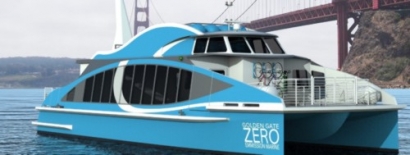
The zero-emission vessel will be the first of its kind in the U.S. and operate within the Red and White fleet out of San Francisco Bay. It is estimated that maritime pollution is a $330 billion problem globally. The project intends to prove that businesses with an elevated environmental consciousness can create viable, cost-effective solutions to mitigate climate change.
The craft, named Water-Go-Round, is a 70-foot aluminum catamaran designed by Incat Crowther. It has a 22-knot top speed, will carry 84 passengers, and will be built by Bay Ship and Yacht in San Francisco Bay. Power for the vessel will be generated by 360 kW of Hydrogenics’ fuel cell power modules in combination with Lithium-ion battery packs.
Daryl Wilson, President & CEO of Hydrogenics, stated, “Having our fuel cells in the first high-speed ferry in the U.S. is another great example of how Hydrogenics is leading the way in zero-emission hydrogen-based technology. We continue to support the maritime industry with first-of-their-kind propulsion power and fueling solutions, incorporating our world-leading advanced hydrogen applications. We look forward to working with GGZEM and its partners.”
There will be a three month study period after the vessel is launched in San Francisco Bay in mid-2019. During this period Sandia National Laboratories will independently gather and assess performance data. CARB will then use the real-world data to verify the suitability of the technology for marine use.
Dr. Joseph W. Pratt, CEO of GGZEM, added, “Hydrogenics is well known as an industry leader and an excellent partner in delivering advanced hydrogen-based power and fueling solutions. Their fuel cells have a proven track record and incorporate numerous innovative features that result in high efficiency and industry-leading reliability, making it a perfect fit for our integrated systems. I look forward to combining our capabilities on this initiative to reduce pollutants and greenhouse gases in the maritime industry.”
Funding for the CARB grant for the country’s first zero-emission ferry comes from California Climate Investments, a statewide program that puts billions of Cap-and-Trade dollars to work reducing greenhouse gas emissions, strengthening the economy and improving public health and the environment — particularly in disadvantaged communities.

